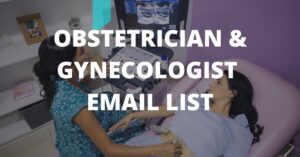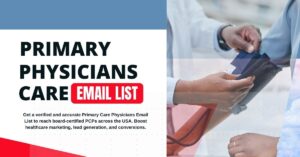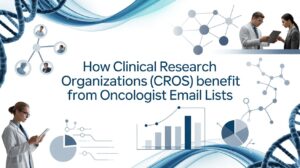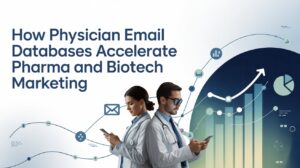Introduction
In today’s digital healthcare landscape, generic mass emails no longer capture the attention of busy physicians and healthcare professionals. With inboxes overflowing, personalization is no longer optional—it’s essential.
This article explores how personalized email marketing strategies can significantly improve engagement with healthcare professionals and drive better outcomes for both providers and patients.
Why Personalization in Email Marketing Matters
Healthcare professionals receive an average of 126 emails per day, making it harder to stand out. Personalized email campaigns break through the noise and establish real connections.
A recent study shows:
- 41.23% open rate for personalized healthcare emails
- 21% open rate for standard, non-personalized emails
“Email marketing personalization has become essential for healthcare providers looking to connect with physicians effectively,” says Dr. Sarah Chen, Chief Digital Officer at Memorial Healthcare System.
“We’ve seen engagement rates triple when we deliver content that speaks directly to a physician’s specialty and interests.”
Why Personalization Is Crucial in Healthcare Communication
Unlike consumers, healthcare professionals have unique concerns, such as:
- Time constraints: Limited time to read long emails
- Specialty-specific interests: Need for targeted, relevant content
- Evidence-based mindset: Preference for data-backed information
- Regulatory compliance: HIPAA and other regulations must be followed
Personalization in this context isn’t just about relevance—it’s about compliance, trust, and value.
Crafting a Personalized Email Strategy: Key Components
1. Email Segmentation for Healthcare Professionals
Segmentation ensures that physicians receive only the content relevant to them.
Types of segmentation:
- Specialty-based (e.g., cardiologists, oncologists)
- Behavioral (past email engagement)
- Geographic (based on region-specific trends)
- Practice type (hospital vs. private clinic)
“We’ve seen a 45% increase in click-through rates when emails are segmented by specialty.” — Mark Johnson, Healthcare Marketing Director, Precision Health Communications
2. Personalized Subject Lines That Get Noticed
Personalized subject lines can increase open rates by up to 29%.
Effective subject line tactics:
- Mention recipient’s specialty
- Reference relevant medical updates
- Include treatment or condition focus
- Highlight time-saving benefits
(e.g., “5-minute update on cardiac care advances”)
3. Tailored Content and Dynamic Integration
To maximize relevance:
- Match content to clinical interests and career stages
- Adapt for hospital or private practice settings
- Use dynamic content blocks for different user types within a single email
Dynamic content ensures every physician sees what’s most relevant to them.
Using Data and Analytics to Improve Results
Key Email Marketing Metrics for Healthcare
Track metrics such as:
- Open rates by specialty
- Click-through rates by content type
- Conversions (downloads, sign-ups)
- Unsubscribes and user feedback
“We discovered most physician engagement occurs between 7–8 AM and after 8 PM.” — Jennifer Williams, Digital Analytics Manager, MedTech Solutions
A/B Testing for Optimization
A/B testing allows for comparison of:
- Subject lines
- Content formats (text vs. visuals)
- CTA wording and placement
- Email send times
Example: A pharma company saw a 37% increase in engagement by testing the best time to email cardiologists.
Best Practices for Designing Physician-Friendly Emails
Mobile Optimization
Since many doctors check emails on their phones:
- Use single-column responsive layouts
- Keep buttons large and clear
- Use concise, bold headlines
- Optimize image loading speed
Concise, Value-Driven Messaging
Physicians spend an average of 49 seconds reading an email.
Tips:
- Get to the point fast
- Use bullet points and short paragraphs
- Use bold headings for scanning
“If you can’t communicate your value in under a minute, you’ve lost the opportunity.” — Dr. Michael Roberts, Chief Medical Information Officer, UMC
Relevant Visuals
Include:
- Clinical visuals (graphs, charts)
- Research outcomes
- Custom illustrations relevant to specialties
Avoid overused stock images—authenticity matters.
Real-World Examples: Personalization Success Stories
UF Health Cancer Center – Orlando Health
- Target audience: Oncologists
- Strategy: Personalized content by sub-specialty
- Results:
- 97% delivery rate
- 26% open rate (35% above industry avg.)
- 7% CTR (138% above avg.)
Midwest Regional Hospital System
- Strategy: Used dynamic content based on specialty and engagement
- Results:
- 43% increase in engagement
- 27% decrease in unsubscribes
National Pharmaceutical Company
- Approach: Segmentation by prescribing behavior and patient needs
- Results:
- 52% increase in downloads
- 31% rise in webinar sign-ups
Conclusion: Adopt a Personalization-First Email Marketing Strategy in 2025
In 2025, personalization in email marketing for healthcare is no longer a trend—it’s a strategic necessity. With tools like AI-driven targeting and dynamic content, marketers can create hyper-relevant email campaigns.
Organizations that prioritize personalization will build trust, engagement, and better professional relationships, ultimately enhancing patient care.
Visit our website Med Stream Data for more healthcare industry related information!







